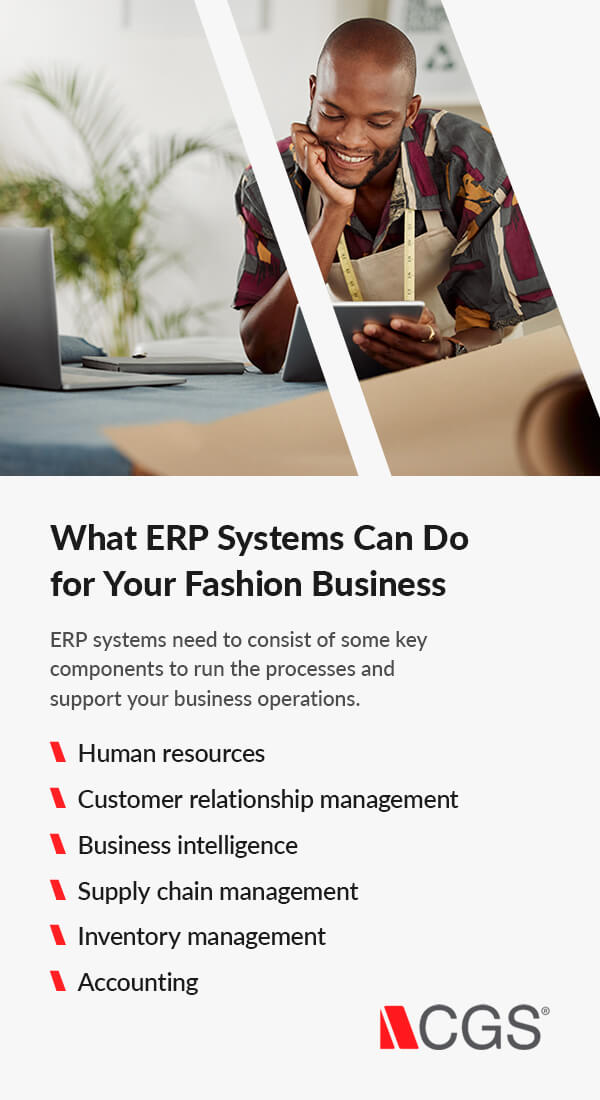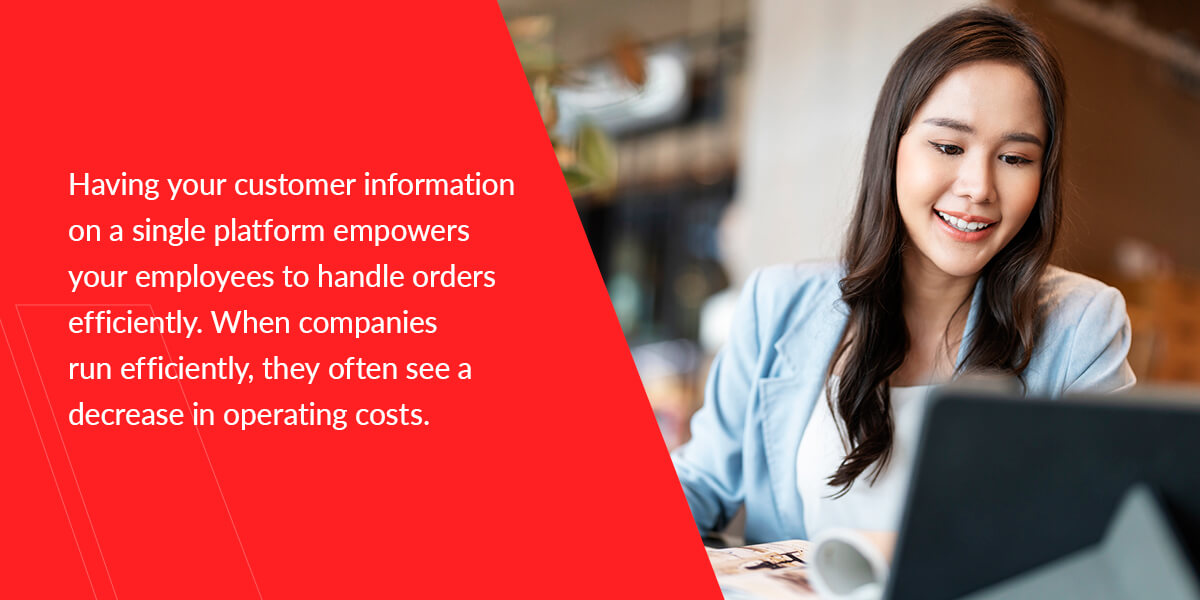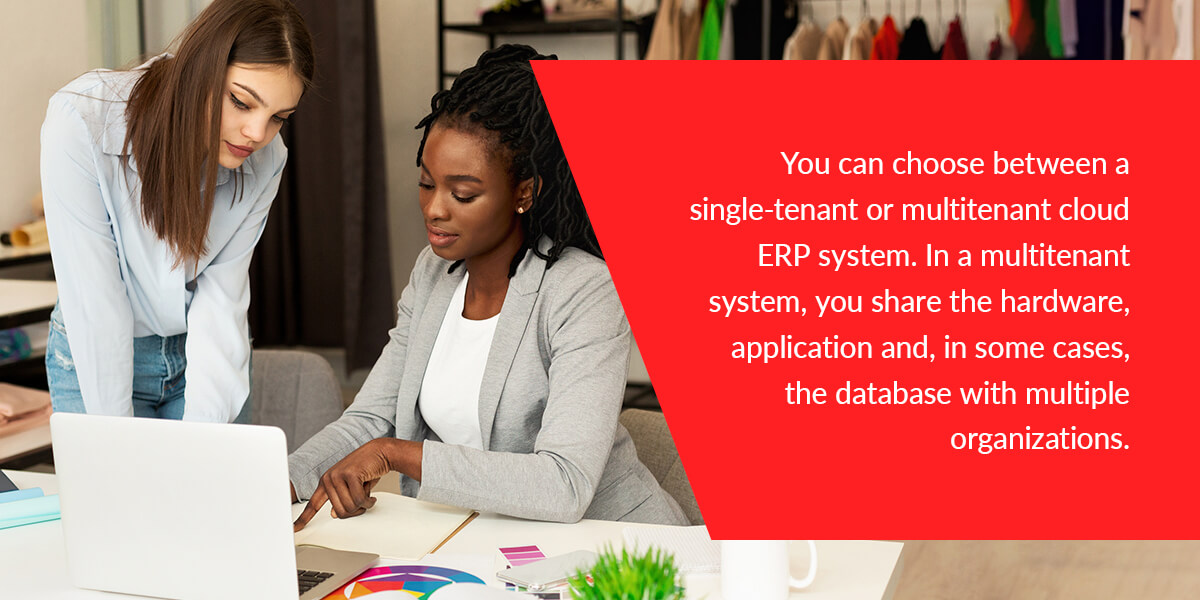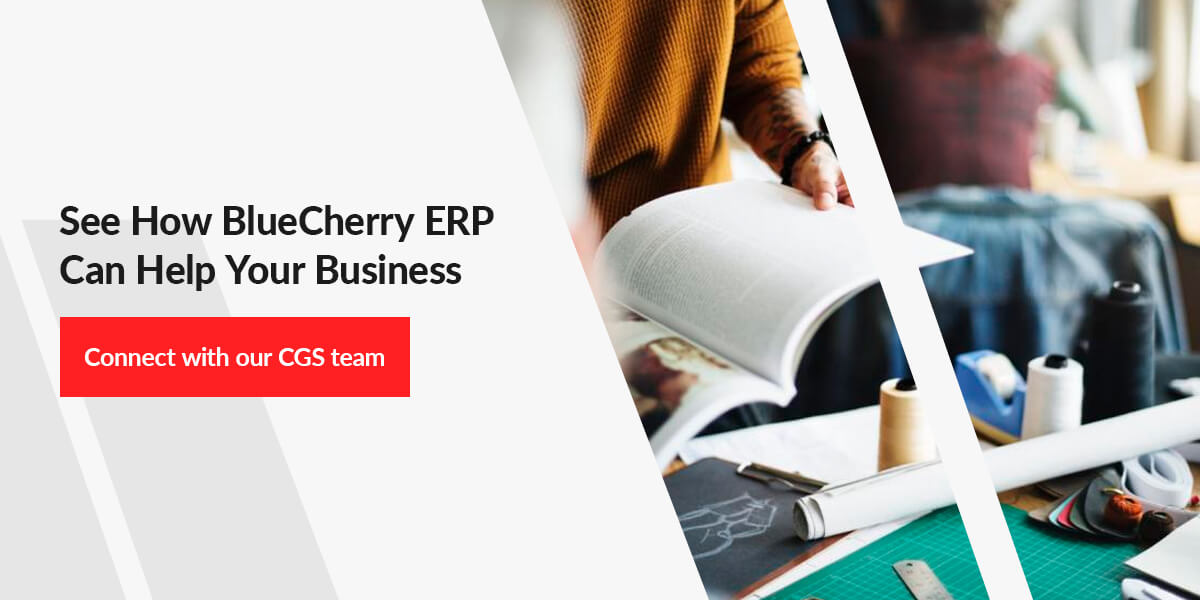
Daniella Ambrogi is Senior Global Marketing Director for CGS's Application Services division, which offers BlueCherry® software and services to 500+ fashion, footwear, consumer goods and retail companies worldwide. Ambrogi offers 20+ years of experience in the fashion and retail business; she understands a brand's complex needs in an ever-changing marketplace.
Topics
Benefits of ERP Systems in the Home Goods and Fashion Industry

In today's fast-paced business world, fashion and home goods brands need an ERP system to streamline operations and empower them to meet consumer demands. ERP, or enterprise resource planning, gives you visibility across your business functions and integrates all your data into one place. Using the features of an ERP system, you can make informed decisions about your business, become more efficient and improve productivity.
What Is ERP?
An ERP system is the tools and software a business uses to manage and integrate its data and operations.
This system enables you to combine all business processes through a single platform. Data is easily stored, managed and accessible to all business functions through this platform. Each department may have its own workflow, but an ERP system creates one interface where all these procedures are accessible. For example, sales, marketing, operations and finance functions may have separate programs that integrate into an ERP system.
ERP tools enable departments to communicate information with each other more effectively and efficiently. Instead of one function sending data to another, which wastes time and creates duplicates, ERP applications streamline the process by enabling teams to access information they need when they need it. Awareness between departments increases — employees see how their functions impact the rest of the business when they can view company-wide data.
How Do ERP Systems Work?
Typically, a company pays a vendor that made the ERP system to maintain it while they pay for the services. These systems have evolved from physical servers requiring manual entry to cloud-based solutions you can access from anywhere.
Your business selects which functions to integrate into the system, and then you work with the ERP vendor to integrate the data and processes from these functions. Once it is up and running, employees can access the server. You can also set permissions for who can retrieve what information.
Types of ERP Systems
There are three main categories of ERP systems that businesses use:
- On-premises: A business installs ERP software on its computers and servers at its location. The cost of this type of system includes a one-off license, software updates, maintenance fees and training. On-premises may be your preferred option if you have concerns about confidential information. You can keep all your data in-house and easily customize the system.
- Cloud-based: This model comes as Software as a Service (SaaS), where you access the data via a network of remote servers. The benefits of this system are that the provider manages it for you, it is more cost-effective and it’s faster to set up than on-premises.
- Hybrid: A hybrid model mixes cloud-based and on-premises models. Businesses often use on-premises software for corporate functions and get their support from cloud-based solutions. Smaller operations can use less complex cloud-based tools while reserving the complex processes for on-premises software.
What ERP Systems Can Do for Your Fashion Business

ERP systems need to consist of some key components to run the processes and support your business operations.
- Human resources: You should be able to manage everything relating to your employees, from recruitment and payroll to talent management and benefits administration.
- Customer relationship management: Integration with this feature enables you to communicate with and manage your customer relationships.
- Business intelligence: Your ERP systems must give more profound insight into your business operations so you can make informed business decisions. This intelligence can look like comprehensive reporting, graphs and other visualizations that interpret complex data.
- Supply chain management: Oversee your manufacturing process, from raw materials to the delivery of finished products.
- Inventory management: This feature ensures you have the correct apparel inventory to meet customer demand.
- Accounting: Being able to track your revenue, expenses, accounts receivable, accounts payable and other financial information is an essential part of an ERP system.
What Are the Benefits of an ERP System?
Businesses acquire ERP tools for several reasons. The needs of each company differ, but these are the top benefits of ERP software each organization in the fashion industry can enjoy.
Increased Accuracy and Productivity
ERP software increases productivity by automating simple, repetitive tasks. This automation frees employees to focus on work that adds value to your business.
Integrating departments makes it easier for staff to gain the information they need to complete projects. An ERP system saves you time because employees have immediate visibility of the data they need for their roles instead of asking around for it. When data passes from one employee to the next, it can lose its integrity.
Having information available on a single platform eliminates redundancies and ensures everyone has the same accurate data. Inaccurate information causes misunderstandings and conflicts, threatens data integrity and wastes resources to fix it.
Immediate Reporting
Accessing real-time reports to inform business decisions is essential in today's competitive fashion landscape. ERP systems offer endless options when it comes to reporting. You can customize reports for functions and compare the performance of each.
These reports help you check how your departments align with your business goals, which are meeting key performance indicators (KPIs), and which have room for improvement. Accurate, real-time reporting enables you to plan, forecast, budget, and communicate the state of your business.
Improved Efficiency

Every function across your business should see improved efficiency from the automation and visibility that comes with an ERP system. Your business processes become less intensive, and this contributes to improved customer service. Having your customer information on a single platform empowers your employees to handle orders efficiently. When companies run efficiently, they often see a decrease in operating costs.
Team Collaboration
Visibility across functions enables departments to work together. When teams work as silos, it makes collaboration a challenge. The integrated systems encourage communication between departments. They can brainstorm to solve problems and see how their function contributes to the company's goals. When employees can work together, it helps align the workforce to achieve the company's mission and vision.
Streamlined Processes
All your business's information is in one place, giving you visibility of all your departments. Companies without ERP systems face the challenge of having information spread throughout the organization, kept in various formats that employees can only access if they ask.
When a department sends data to another, it results in inconsistent duplicates. With one platform, you can streamline and centralize your data and store it in the same format. All employees have access to the same reliable information.
Data Security
If you handle sensitive data — like information about design and manufacturing processes — data security is a priority. Without an ERP system, employees store this confidential information on their computers, which have different levels of security. Passing information around by email poses the risk of compromise. Having all your data stored in one secure location increases protection.
You can also control which employees have access to what information. One of the safety advantages of ERP systems is that businesses can set permissions to grant teams visibility only to the information they need for their roles, reducing the risk of fraud.
Consistent Compliance
ERP tools make staying compliant with industry regulations easier. Up-to-date and accurate information help reduce the work you need to do to track and maintain compliance. It also makes it easier for auditors to retrieve the information they need to review.
Some ERP tools even support specific financial standards and regulations. They automatically update the system to show regulation changes so you can adjust remain compliant.
High Scalability
An ERP can scale with you no matter how big your business gets. If you are a small fashion brand, you can access what you need now and add more features as your business grows. You can also give access to new staff members as you hire employees.
Cloud-based systems are the easiest to scale with, as the vendor already has the capabilities to handle demand. You can save on hiring technical experts to make the changes you need.
Cost Savings
Automating processes can reduce your operational and administrative costs. The deeper insight from ERP systems enables you to spot cost-saving opportunities. You can see which areas of your business are wasting resources and where you can cut back on expenses, such as by choosing new suppliers or manufacturers.
Streamlining your processes and operations also improves your planning, saving you money. For example, you can avoid over or under-ordering materials, which can cost your business. You can either extend those savings to your customers or reinvest the funds into developing a new fashion line or expanding your current offerings.
Choosing an ERP System
Before you choose an ERP system, knowing what to look for is essential. We've compiled a list of tips to help you choose the right vendor for your fashion business so you can make the most of the ERP system benefits.
Analyze Your Business Needs
Before you choose an ERP system, analyze your current business processes, and identify areas of improvement. Assign each function with a designated team member to talk to departments, from design to sales and customer service, and find out what support they need in a system, along with desired features to improve workflow. Using this feedback, you can create a list of requirements a system needs to meet to be the right fit for your company. Many ERP systems are customizable to fit your business purposes.
Once you have integrated your ERP software into your business, you can use your requirements list to check the system's effectiveness and measure your return on investment (ROI).
Consider Cost of Ownership vs. Return on Investment
Start with having a budget of how much you are willing to spend. Avoid assuming the most expensive ERP system is the best — this is only sometimes the case. The most important thing to consider is how the software works for and integrates with your business.
The type of system you choose will impact your cost and ROI. On-premises ERP tools usually have a higher cost of ownership, so it takes longer to realize your ROI. You'll need to invest in hardware and software and incur training, maintenance, and tech support costs. Some of these costs are one-offs, but there will be ongoing expenses, especially as your business grows.
A cloud-based ERP often has a lower cost of ownership. The system is set up, hosted and maintained by a vendor, reducing and eliminating many expenses associated with an on-premise system. Typically, you pay the vendor a monthly fee, and they handle the updates and maintenance for you.
Look out for Key Features
Each of your departments will have different needs, but a sound ERP system should enhance collaboration and data sharing between departments through an intuitive interface and dashboard. KPIs and reports should be accessible and easy to read. Business intelligence, data security and data mining capabilities are all helpful features of a sound system.
Your ERP will also need to adapt as your business grows and changes. An inflexible system will bring you more frustration in the long run. To avoid this, prioritize choosing a flexible and developable system for your business. Making changes to your processes will also help you maintain a competitive edge.
Enquire About Support and Training
From the initial integration to ongoing daily operations, you'll need support and employee training from your vendor. Ask the provider what type of initial training and ongoing support they provide and how long the response time is should you require assistance. Some vendors may charge an additional fee for managed support. Your ERP is essential in running your business, so choosing a provider that will give you the support you need is beneficial.
Seek Seamless Integration
The system you choose should integrate well with your existing systems and applications. By using connectors, your vendor should enable the ERP software to synchronize with data among all systems in real time. That capability ensures all the data is up-to-date and consistent.
Choose Customizable Software

Customization may be optional if your business is still growing, but it will become important as you scale. Customization may also help determine the type of cloud-based system you use.
You can choose between a single-tenant or multitenant cloud ERP system. In a multitenant system, you share the hardware, application and, in some cases, the database with multiple organizations. In contrast, you have dedicated software as a single tenant, making customization accessible.
Opt for a Tech-Forward Solution
New technological advances occur regularly, and your ERP software should be compatible with these changes. Machine learning, the cloud and artificial intelligence (AI) are examples of technologies that your business should be able to harness through your ERP.
These tech-forward solutions can help provide deeper analysis and insights, enable you to predict fashion trends and create a personalized experience for shoppers. A system that can adapt and integrate new technologies will empower you to keep up with industry changes.
Prioritize ERP Vendors That Serve Your Industry
Business processes and requirements vary across industries. It's wise to select a vendor that serves your sector to receive the best benefits of enterprise resource planning and support from your system. Choosing a fashion industry-specific system will make integration more accessible and increase your business's efficiency.
At CGS, our BlueCherry® Enterprise Software delivers solutions to fashion, apparel, footwear and home goods companies. In today's highly competitive business world, we understand companies in this industry need an effective and efficient ERP system that can keep up with demand and streamline business operations.
See How BlueCherry ERP Can Help Your Business

The fashion industry is ever-changing. As trends evolve, customers seek new and innovative products and consistent new releases. BlueCherry ERP provides fashion and home goods companies with an ERP solution that helps them overcome the industry's challenges. Our system offers real-time organization visibility, so you can become more agile and have tighter control over your supply chain. BlueCherry ERP also includes BlueCherry Business Intelligence, which empowers you to make strategic decisions and generate reports and analytics.
To learn more about how BlueCherry can help your business, connect with our CGS team today!

Daniella Ambrogi is Senior Global Marketing Director for CGS's Application Services division, which offers BlueCherry® software and services to 500+ fashion, footwear, consumer goods and retail companies worldwide. Ambrogi offers 20+ years of experience in the fashion and retail business; she understands a brand's complex needs in an ever-changing marketplace.

